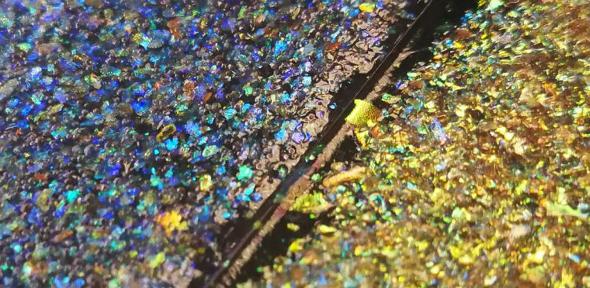
Cambridge researchers have developed a sustainable, plastic-free glitter for use in the cosmetics industry – made from the cellulose found in plants, fruits, vegetables and wood pulp.
Beyond its general annoyance factor, glitter is made of toxic and unsustainable materials, and contributes to plastic pollution. Now, researchers from the University of Cambridge have found a way to make sustainable, non-toxic, vegan, and biodegradable glitter from cellulose – the main building block of cell walls in plants, fruits and vegetables – and it’s just as sparkly as the original.
The glitter is made from cellulose nanocrystals, which can bend light in such a way to create vivid colours through a process called structural colour. The same phenomenon produces some of the brightest colours in nature – such as those of butterfly wings and peacock feathers – and results in hues that do not fade, even after a century. Using self-assembly techniques that allow the cellulose to produce intensely-coloured films, the materials could be used to replace the plastic glitter particles and tiny mineral effect pigments which are widely used in cosmetics. In Europe, the cosmetics industry uses about 5,500 tonnes of microplastics every year.
“Conventional pigments, like your everyday glitter, are not produced sustainably. T hey get into the soil, the ocean and contribute to an overall level of pollution. Consumers are starting to realise that while glitters are fun, they also have real environmental harms.”” - Prof Silvia Vignolini, Yusuf Hamied Department of Chemistry
Professor Vignolini’s research group has extracts cellulose from wood pulp, transforming it into shiny, colourful materials, which could be used to replace toxic pigments used in numerous consumer products, such as paints and cosmetics. The research team was able to fully control the self-assembly process, so that the material could be made on a roll-to-roll machine. Their process is compatible with existing industrial-scale machines. Using commercially available cellulose materials transformed into suitable liquid suspension in just few steps, the team showed continuous deposition and drying of the cellulose-containing suspension on a commercial roll-to-roll machine.
Following the large-scale cellulose films production, these were ground into particles-size for use in glitters or effect pigments. The resulting particles are biodegradable, plastic-free and non-toxic. The demonstration of the fabrication process on commercial equipment is an important step towards making the new material available outside the lab.
Original University of Cambridge full article.
Benjamin E. Droguet et al. ‘Large-scale fabrication of structurally coloured cellulose nanocrystal films and effect pigments.’ Nature Materials (2021). DOI: 10.1038/s41563-021-01135-8

